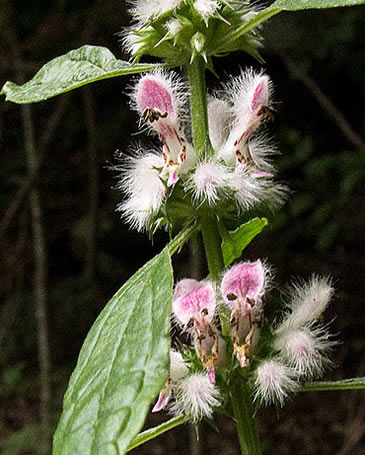From the perennial root-stock rise the square, stout stems, 2 to 3 feet high, erect and branched, principally below, the angles prominent. The leaves are very closely set, the radical ones on slender, long petioles, ovate, lobed and toothed, those on the stem, 2 to 3 inches long, petioled, wedge-shaped; the lower roundish, palmately five-lobed, the lobes trifid at the apex, the upper three-fid, coarsely serrate, reticulately veined, the veinlets prominent beneath, with slender, curved hairs. The uppermost leaves and bracts are very narrow and entire, or only with a tooth on each side, and bear in their axils numerous whorls of pinkish, or nearly white, sessile flowers, six to fifteen in a whorl. The corollas, though whitish on the outside, are stained with paler or darker purple within. They have rather short tubes and nearly flat upper lips, very hairy above, with long, woolly hairs. The two front stamens are the longest and the anthers are sprinkled with hard, shining dots.

Old writers tell us that there is no better herb for strengthening and gladdening the heart, and that it is good against hysterical complaints, and especially for palpitations of the heart when they arise from hysteric causes, and that when made into a syrup, it will allay inward tremors, faintings, etc. There is no doubt it has proved the truth of their claims in its use as a simple tonic, not only in heart disease, neuralgia and other affections of the heart, but also in spinal disease and in recovery from fevers where other tonics are inadmissable.
